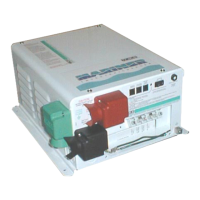)($785(6
&RS\ULJKW7UDFH(QJLQHHULQJ&R,QF 7HOHSKRQH 3DUW1XPEHU
WK
6WUHHW1( )D[ 2FWREHU
$UOLQJWRQ:$86$ ZZZWUDFHHQJLQHHULQJFRP
3DJH
Over Current Cut Out
Mariner inverter/chargers are protected from over-current conditions. When the load being run
demands more current than the inverter can safely supply, the inverter will momentarily shutdown,
turn off if it encounters an over-current condition for approximately 20 seconds (a prolonged short-
circuit) or if the AC output is connected to another AC power source (shorepower or generator).
Battery Type Optimization
Mariner inverter/chargers are designed to prevent damage to and extend the useful life of your
batteries by regulating the charging voltage and duration. To do this, the inverter/charger must be
configured for the type of batteries in the system. The Mariner is pre-configured for optimum
charging of gel-cell type batteries at 14.1 volts in bulk charging mode, and 13.5 volts in float charging
mode. For liquid lead-acid batteries, you can reset the Mariner using the RC7 remote control to bulk
charge at 14.5 volts and float charge at 13.4 volts. For a complete discussion of batteries and battery
charging techniques, see the
Batteries
and the
Three-Stage Battery Charger
sections of this manual.
Charge Rate Regulation
Batteries can overheat if the charge rate is too high. The Mariner inverter/charger protects your
batteries by enabling you to limit the charge rate using the RC7 remote control. The charge rate is
set at the factory to 100% of maximum, which may be up to 140 amps depending upon the model
you have purchased (see
Appendix D: Specifications
to determine the maximum possible charge
rate for your model). For smaller battery banks, this may be too high.
The highest charge rate recommended is determined by dividing the battery bank’s amp hour
capacity by a factor of three or five (3 for gel cell - 5 for lead acid).
Table 1, Recommended Maximum Charging Rates
Battery Capacity in Amphours Recommended Maximum Charge Rate in Amps
Gel Cell Lead-Acid Liquid Lead-Acid
125 40 25
250 20 50
500 140 100
Setting the charge rate at the highest recommended level is best when the objective is to charge the
batteries as quickly as possible. A much lower setting can be used in installations where AC power is
typically available for periods of several hours. There is more than sufficient time for a 400-amphour
battery bank to be recharged in 24 hours at a 25-amp setting.
Example: 25 amps X 24 hours = 600 amp/hrs.

